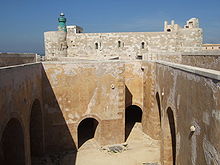Maniace Castle
The Castello Maniace is a fortress in Syracuse on the east coast of Sicily . The fortress is located on the southern tip of the Ortygia peninsula , on which the old town of Syracuse is also located.
history
The current fortress Castello Maniace was built in the time of Frederick II from 1232 to 1240. In front of that there was a fortress belonging to the Byzantine general Georg Maniakes . In 1038 he succeeded in retaking Syracuse for the Norman rulers, from whom he was paid. Syracuse had previously been in Arab hands. In 1704 a powder chamber exploded in the fortress, which destroyed large parts of the interior of the fort. Externally, the fortress has remained almost unchanged, but the upper floors were removed in the 17th century. Since 2004 it can be visited again after a renovation, since meanwhile the military restricted area in the area of the port of Syracuse, which made the tour very difficult, has been lifted.
architecture
The Castello Maniace rises above a square plan. There is a round corner tower at every corner. The interior consisted of a single, gigantic hall, the ceiling of which was supported by large ribbed vaults that rested on huge columns. These columns were crowned (partially preserved) by exceptionally richly sculpturally decorated capitals, which are unique in the secular architecture of the Middle Ages around the Mediterranean. In addition to the extraordinary capitals, the box ribs of each vault, which can be traced back to Cistercian contexts ( Clairvaux monastery ), are striking on the ribbed vaults. A small niche was discovered on the eastern outer side, which corresponds to Islamic prayer niches of mosques. What purpose it served in this room is still unclear. Originally the fort had one or two upper floors, which gave the entire complex a steep vertical proportion, similar to a donjon . Today's broad impression is the result of a renovation during the Spanish rule in southern Italy, when the upper floors of many medieval (Staufer) forts were removed in order to offer cannons less attack surface, as was the case with the port forts in Catania and Augusta .
The fortress was built at a point on the peninsula from which it could optimally protect the port entrance of Syracuse. The fortress was not only a military garrison, but also a royal palace during the reign of Frederick II.
The portal from the Hohenstaufen era is well worth seeing , surrounded by two ancient ram sculptures from the 4th century BC. Was flanked. One of the bronze rams is in the Archaeological Museum of Palermo , the second was destroyed during the riots in 1848 . A Spanish coat of arms was placed above the portal in the 16th century.
In memory of Emperor Friedrich II , a Staufer stele was erected in June 2018 to the left of the entrance to the square Hohenstaufen building .
literature
- Alexander Knaak: Prolegomena to a corpus work of the architecture of Frederick II of Hohenstaufen in the Kingdom of Sicily 1220-1250 . Marburg 2001, ISBN 3-89445-278-1 (on Castello Maniace pp. 47-58 with an overview of the state of research and theses on the interpretation of the building).
Web links
- Itinerari culturali del medioevo siciliano: Castello Maniace (Italian)
- Un sito sul castello Maniace
- Semper sul Castello
Individual evidence
- ↑ Siracusa 2018 on stauferstelen.net. Retrieved June 30, 2018.
Coordinates: 37 ° 3 ′ 13 ″ N , 15 ° 17 ′ 43 ″ E






